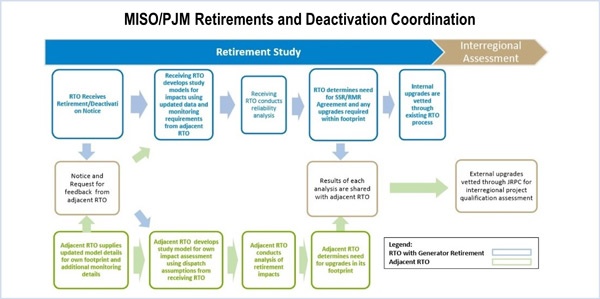By Amanda Durish Cook
MISO and PJM will have 65 days to evaluate the impact of generator retirements under joint operating agreement language drafted to comply with a FERC directive.
The subject of a briefing at MISO’s Reliability Subcommittee meeting last week, the JOA language requires the RTOs to notify each other of retirements and exchange the most up-to-date modeling data.
The results of the retirement impact studies and possible transmission upgrades will also be shared. Projects in one RTO that have benefits or impacts in the neighboring RTO will be evaluated by the Joint Regional Planning Committee and the Interregional Planning Stakeholder Advisory Committee (IPSAC).
Alternatives to transmission upgrades will include market-to-market coordination to use external resources, as well as operating guides and procedures involving the adjacent RTO.
In response to a complaint by Northern Indiana Public Service Co., FERC required the RTOs to file language coordinating their generator retirement studies and dispatch assumptions by Dec. 15, 2016 (EL 13-88).
The commission cited NIPSCO’s testimony that PJM used unrealistic dispatch assumptions in its study of the retirement of the Crawford and Fisk generating plants in the Commonwealth Edison territory, “which caused PJM to fail to identify required upgrades and masked potential problems within MISO, including overloads on NIPSCO’s system.” (See FERC Orders Changes to MISO-PJM Interregional Planning.)
Joe Reddoch of MISO’s System Support Resource Planning Group said MISO focused on appropriate communication between the RTOs and reviewed its existing retirement process to make sure it was still relevant.
Reddoch commented on the 65-day deadline for evaluating retirements.
“Currently, it’s more or less open-ended. We don’t necessarily have a deadline to get back to them with study results that would factor into their retirement studies,” Reddoch said.
He added that supplying such information would be more vital to PJM, which — unlike MISO — cannot force generators to stay online as must-run resources.
Reddoch said transmission projects the RTOs identify as a result of their analyses might not be detailed or polished.
“Each RTO would conduct a retirement analysis to determine the impacts to their system and possible transmission projects. We won’t necessarily have those projects defined,” he said.
Reddoch said MISO would look to PJM’s information to update its modeling information, but directly involving PJM staff in retirement decisions would be too complex. “They won’t necessarily be involved in study scope discussions,” he said.
In comments to MISO, NIPSCO said it was generally supportive of the proposed changes, but it asked the RTOs to devise a timeline for retirement studies that is similar to MISO’s multistep interconnection queue studies. MISO responded that an interconnection format isn’t feasible because its generator retirement studies are “conducted on an ad hoc basis,” and studies can vary.
NIPSCO also asked MISO for examples of how identified transmission projects become approved under the new process. MISO said the issue would be discussed at a future IPSAC meeting.
Reddoch asked for stakeholder input by Nov. 1 and said MISO would share final JOA language at the Nov. 15 Joint and Common Market meeting with PJM.




